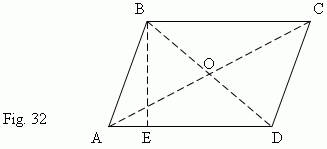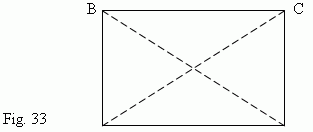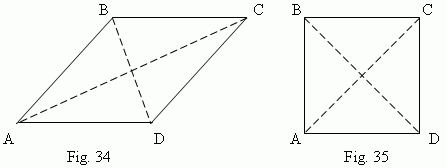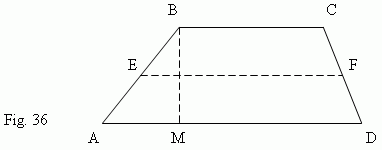Parallelogram and trapezoid
Signs of a parallelogram. Rectangle. Rhombus.
Square. Trapezoid. Isosceles trapezoid.
Midline of a trapezoid and a triangle.
Parallelogram ( ABCD, Fig.32 ) is a quadrangle, opposite sides of which are two-by-two parallel.

Any two opposite sides of a parallelogram are called bases , a distance between them is called a height ( BE, Fig.32 ).
Properties of a parallelogram.
1. Opposite sides of a parallelogram are equal ( AB = CD, AD = BC ).
2.
Opposite angles of a parallelogram are equal
(
![]() A =
A =
![]() C,
C,
![]() B =
B =
![]() D ).
D ).
3.
Diagonals of a parallelogram are divided in their intersection point into two
( AO = OC, BO = OD ).
4.
A sum of squares of diagonals is equal to a sum of squares of four sides
:
AC
²
+ BD
²
= AB
²
+ BC
²
+ CD
²
+ AD
²
.
Signs of a parallelogram.
A quadrangle is a parallelogram, if one of the following conditions takes place:
1. Opposite sides are equal two-by-two ( AB = CD, AD = BC ).
2.
Opposite angles are equal two-by-two
(
![]() A =
A =
![]() C,
C,
![]() B =
B =
![]() D ).
D ).
3. Two opposite sides are equal and parallel ( AB = CD, AB || CD ).
4. Diagonals are divided in their intersection point into two ( AO = OC, BO = OD ).
Rectangle.
If one of angles of parallelogram is right, then all angles are right (why ?). This parallelogram is called a rectangle ( Fig.33 ).

Main properties of a rectangle.
Sides of rectangle are its heights simultaneously.
Diagonals of a rectangle are equal: AC = BD.
A square of a diagonal length is equal to a sum of squares of its sides’ lengths ( see above Pythagorean theorem ):
Rhombus. If all sides of parallelogram are equal, then this parallelogram is called a rhombus ( Fig.34 ) .

Diagonals of a rhombus are mutually perpendicular
( AC
![]() BD )
and divide
its angles into two
(
BD )
and divide
its angles into two
(
![]() DCA =
DCA =
![]() BCA,
BCA,
![]() ABD =
ABD =
![]() CBD etc. ).
CBD etc. ).
Square is a parallelogram with right angles and equal sides ( Fig.35 ). A square is a particular case of a rectangle and a rhombus simultaneously; so, it has all their above mentioned properties.
Trapezoid is a quadrangle, two opposite sides of which are parallel (Fig.36).

Here AD
||
BC. Parallel sides are called
bases
of a trapezoid, the two others ( AB and CD ) –
lateral sides.
A distance between bases
(BM) is a
height.
The segment EF, joining midpoints E and F of the lateral sides, is called a
midline
of a trapezoid.
A midline of a trapezoid is equal to a half-sum of bases:

and parallel to them:
EF || AD and EF || BC.
A trapezoid with equal lateral sides ( AB = CD ) is called an
isosceles
trapezoid.
In an isosceles trapezoid angles by each base, are equal
(
![]() A =
A =
![]() D,
D,
![]() B =
B =
![]() C ).
A parallelogram can be considered as a particular case of trapezoid.
C ).
A parallelogram can be considered as a particular case of trapezoid.
Midline of a triangle is a segment, joining midpoints of lateral sides of a triangle. A midline of a triangle is equal to half of its base and parallel to it. This property follows from the previous part, as triangle can be considered as a limit case (“degeneration”) of a trapezoid, when one of its bases transforms to a point.